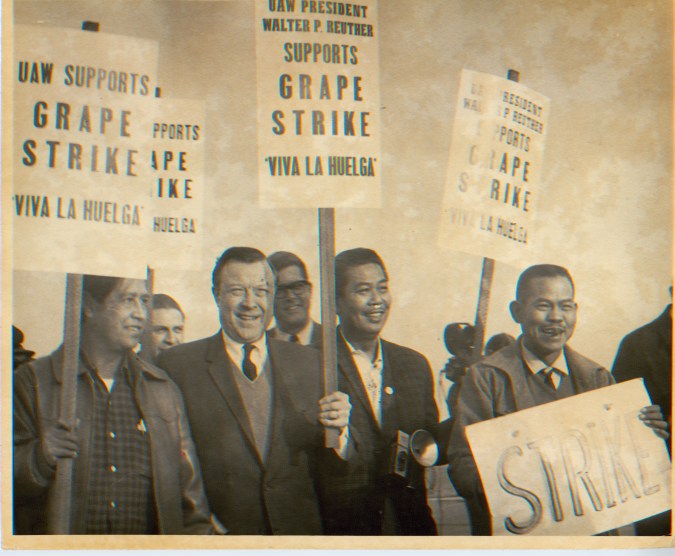Want to find ways to mobilize a successful resistance to the current administration? Look at what past groups have to done to combat discriminatory practices and incendiary rhetoric. If there’s one thing American history can teach us is that people of color have long been fighting the very battles that are facing us today. That’s the spirit behind the Remezcla and Skylight pictures film series #Resist which this coming week will be looking at one of the most well-known labor movements of the twentieth century.
The Delano Manongs: Forgotten Heroes of the United Farm Workers tells the story of how a group of Filipino farm workers instigated The Delano Grape Strike of 1965 that brought about the creation of the United Farm Workers Union (UFW). The movie will be shown at the next edition of the BK@24FPS #Resist Film Series on June 8th, followed by a Q&A with the film’s producer Niall McKay. Ahead of its screening, Remezcla chatted with its director, Filipino American Marissa Aroy, about the need to tell these oft-forgotten stories and why they remain useful in 2017. Check out our chat below.
On how she first learned of Filipino involvement in the UFW
I had grown up in that area in California. My grandma and my grandpa were in Delano, California. So he was of that same generation. I grew up around farm workers and that was always something in the background but our family was never directly involved with any of that stuff. It wasn’t really until I became a documentary filmmaker that I started to learn about the Filipino involvement with the UFW. I had grown up knowing about Cesar Chavez and his hunger strikes, but that’s when I became cognizant. As I got older, people started to suggest ideas for documentaries and somebody told me to read an article – about the UFW and Larry Itliong, Pete Velasco, Philip Vera Cruz, about their contributions—how there has been a group of Filipinos who were working in the great fields for a long time. So that’s how I found out about it.

On finding the funding for the doc
With documentaries it’s always a matter of how to get the money for them. For us it’s about writing for grants. Getting some and not others. It took 7 years for us to get this one made. We approached individual donors—this was before Kickstarter, so it was about trying to get individuals to write checks. Also, PayPal was just beginning to have a way to send money, so we benefited a little from that as well.
“The Filipino community were the ones who really supported us making this documentary and gave us new legs to get it done.”
And I had a little bit of a roadshow in California, where I would bring another documentary I had done with the Sacramento Public Television Station called Little Manila. I would bring that around with me to different Filipino community groups and show the trailer for Delano Manongs and say “This is what we’ve got and this is what we’re looking to do, and please give your money.”
I have to say, by the time that I was starting to do that, I was really burnt out. I felt like, maybe—and this is sort of that colonial mentality—maybe it’s not worth it. Maybe nobody wants to hear about this history. Maybe Filipinos aren’t interested enough. It was really the community and the support they gave. Not just the financial support, but also the emotional support, of hearing like “Oh, they’re finally gonna cover this!” They were the ones who really supported us making this documentary and gave us new legs to get it done. You need that feedback, because by that point, it had been a few years and really it’s just your own stamina of “I’m gonna keep working on this!” Ultimately, it was two organizations: the National Center for Asian-American Media and then the clincher really was the Independent Television Services. That big grant that they gave us was the reason we were able to finish it. These are two organizations that are funded by the Corporation for Public Broadcasting. I would never have had a career without CPB.
On how the film has a hopeful message of unity
It really is about uniting all of these different groups together and being united for this one cause. For us, in present day, that is really important to consider. For Filipino Americans in particular, there is a certain dividing line between the more traditional Filipino immigrants (or first generation) and some of the more liberal Filipino Americans (you know, second or third generation). And a lot of that has to do with the politicizing of our religious beliefs—making the debate over abortion rights as the reason for defining where we are politically. Meaning, that you have Republican Filipinos and you have Democrat Filipinos, and yet we have so many other issues that would unite. Number one being immigration. I think the big challenge is to unite us over that and where this current administration stands on it. Just figuring out how to communicate between the parties. And I think all the immigrant groups are united for this cause, so it’s not just the Filipinos between the Democrats and the Republicans. We’re united with Sikhs, Latinos, Europeans, even.
Join us for #Resist: Learning from the Farm Workers Movement on June 8 from 7:30 p.m. – 10 p.m. Tickets are $10. Reserve your ticket on Union Doc’s website. Add your friends to the Facebook Invite.




